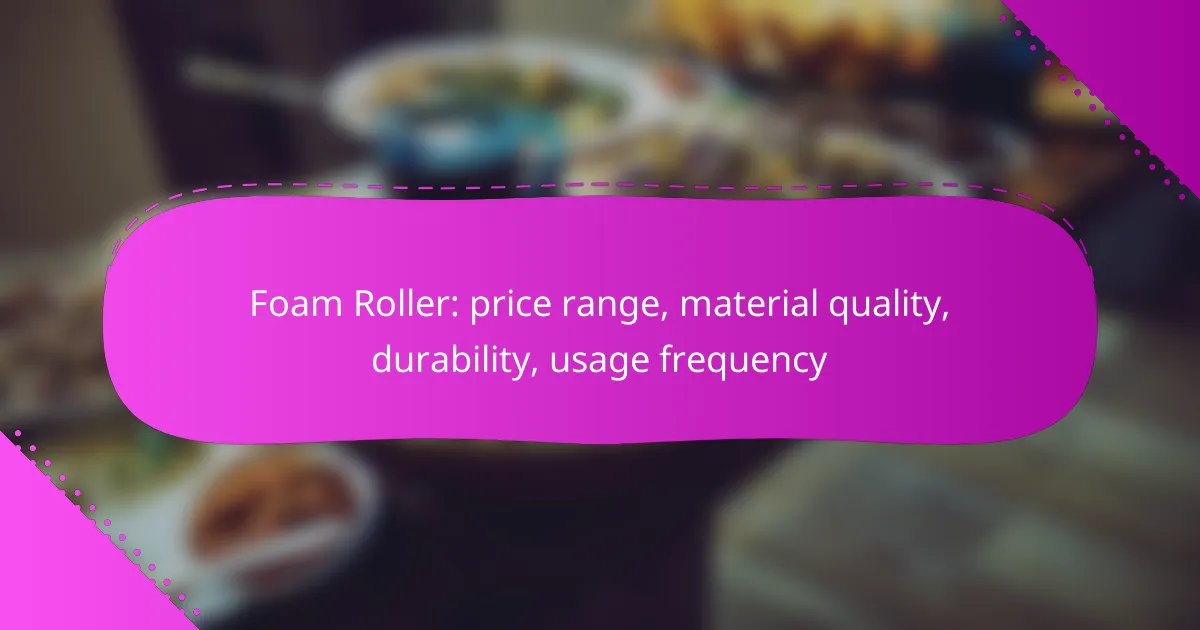Foam rollers are available in a price range of approximately AUD 10 to over AUD 100, influenced by material quality, brand, and features. The quality of materials used plays a crucial role in determining the roller’s durability, comfort, and overall effectiveness. Higher-density foam and superior construction can enhance longevity and performance, making it essential to consider these factors based on your intended usage frequency.

What is the price range of foam rollers in Australia?
The price range of foam rollers in Australia typically varies from around AUD 10 to over AUD 100, depending on factors like material quality, brand, and features. Understanding this range can help you choose a foam roller that fits your budget and usage needs.
Budget foam rollers under AUD 30
Budget foam rollers, priced under AUD 30, are often made from basic foam materials. These rollers are suitable for beginners or occasional users who want to try foam rolling without a significant investment.
While they may lack advanced features, such as textured surfaces or higher density foam, they can still provide basic muscle relief and improve flexibility. Look for options that are lightweight and easy to store.
Mid-range foam rollers AUD 30 to AUD 70
Mid-range foam rollers, costing between AUD 30 and AUD 70, generally offer better durability and material quality. These rollers often feature higher-density foam, which provides more effective muscle relief and can withstand frequent use.
Many mid-range options come with added features like textured surfaces for deeper tissue massage. They are ideal for regular users, such as athletes or fitness enthusiasts, who need a reliable tool for recovery.
Premium foam rollers over AUD 70
Premium foam rollers, priced over AUD 70, are typically made from high-quality materials designed for serious athletes and frequent users. These rollers often incorporate advanced technologies, such as vibration or specialized foam types, to enhance recovery and performance.
Investing in a premium foam roller can provide significant benefits, including improved durability and effectiveness in muscle recovery. Consider these options if you are committed to a regular foam rolling routine and seek the best results.
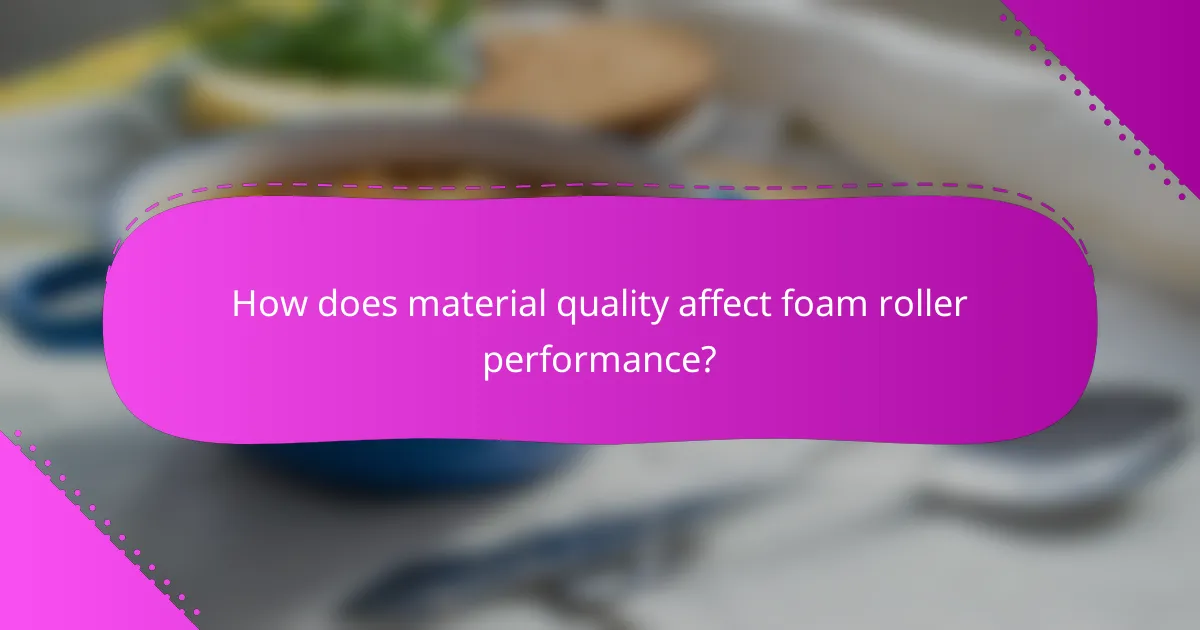
How does material quality affect foam roller performance?
Material quality significantly influences foam roller performance, impacting durability, comfort, and effectiveness. High-quality materials can enhance the roller’s longevity and provide better support during use, while lower-quality options may wear out quickly and offer less comfort.
EVA foam rollers for durability
EVA (Ethylene Vinyl Acetate) foam rollers are known for their durability and resistance to wear. These rollers typically maintain their shape over time, making them suitable for frequent use in both home and gym settings. They are often priced in the mid-range, usually between $20 and $50, depending on the brand and size.
When selecting an EVA foam roller, consider the density. Higher density options provide more firmness, which can be beneficial for deeper tissue massage, while softer versions may be better for beginners or those with sensitive muscles.
Polyurethane foam for comfort
Polyurethane foam rollers are designed for enhanced comfort and are often softer than EVA options. This makes them ideal for users who prioritize a gentler experience, especially during recovery sessions. Prices for polyurethane rollers can range from $15 to $40, depending on features like texture and size.
While polyurethane rollers may not be as durable as EVA, they can still provide effective muscle relief. Users should be aware that these rollers might compress more quickly, so regular inspection for wear is advisable to ensure optimal performance.
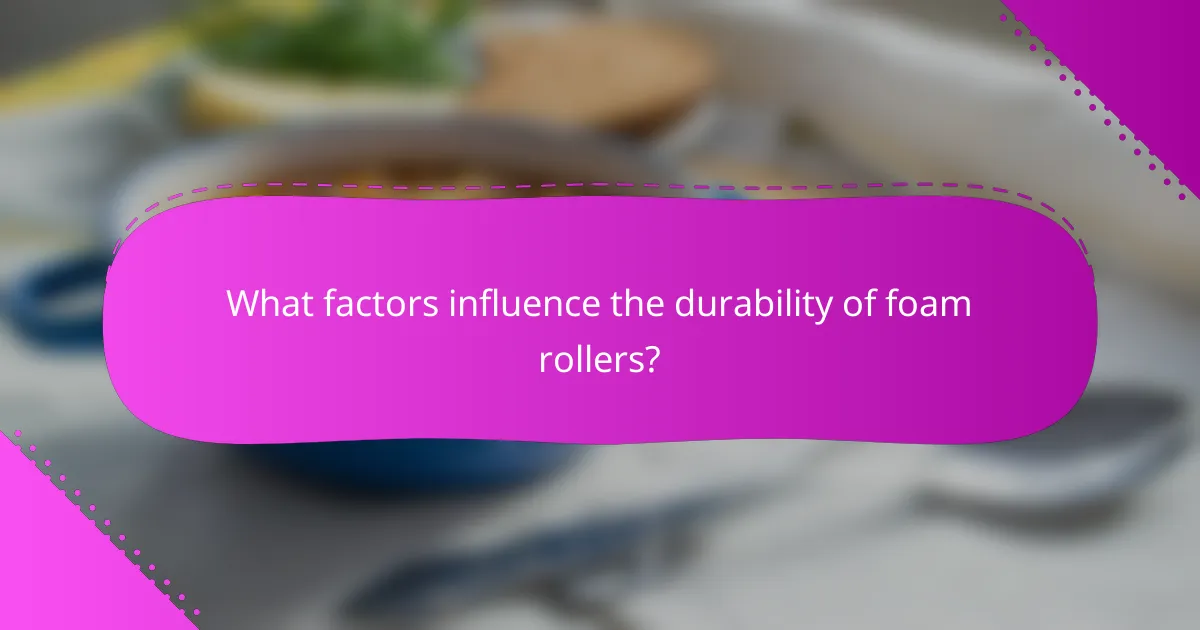
What factors influence the durability of foam rollers?
The durability of foam rollers is primarily influenced by the density of the foam material and the quality of construction and design. These factors determine how well the roller withstands repeated use and maintains its shape over time.
Density of foam material
The density of foam material plays a crucial role in the durability of foam rollers. Higher density foam tends to be more resilient and can endure greater pressure without losing its shape. For example, high-density rollers are often recommended for athletes as they provide better support and longevity compared to low-density options.
When selecting a foam roller, consider that medium to high-density options typically range from 25 to 45 kg/m³. This range offers a good balance between comfort and durability, making them suitable for regular use.
Construction quality and design
The construction quality and design of foam rollers significantly affect their lifespan. Rollers with solid cores or those that are molded rather than glued tend to be more durable. Look for features such as reinforced edges and seamless designs, which help prevent wear and tear.
Additionally, consider the intended use. For frequent use, especially in a gym setting, investing in a well-constructed roller can save money in the long run by reducing the need for replacements. Always check for user reviews and product warranties to gauge the durability of specific models.
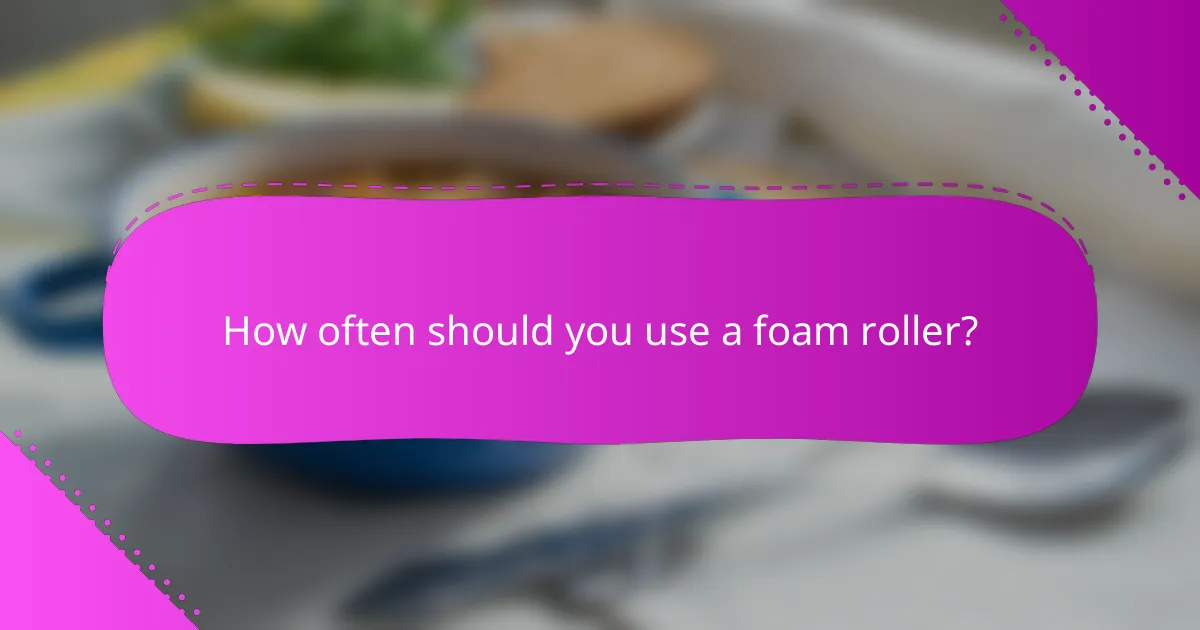
How often should you use a foam roller?
Using a foam roller regularly can enhance muscle recovery and flexibility. For optimal results, the frequency of use should align with your activity level and fitness goals.
Daily usage for athletes
Athletes often benefit from daily foam rolling to maintain muscle elasticity and prevent injuries. Incorporating foam rolling into a daily routine can help alleviate muscle soreness and improve performance.
For athletes, targeting specific muscle groups for about 10-15 minutes each day can be effective. Focus on areas that feel tight or sore, rolling slowly over knots to release tension.
Weekly usage for casual users
Casual users should aim for foam rolling at least 2-3 times a week to support recovery and flexibility. This frequency can help alleviate muscle tightness from everyday activities or light exercise.
Spending around 5-10 minutes per session on major muscle groups, such as the back, legs, and arms, can yield positive results. Prioritize rolling after workouts or on rest days to maximize benefits without overdoing it.

What are the benefits of using foam rollers?
Foam rollers offer several benefits, primarily aiding in muscle recovery, enhancing flexibility, and improving mobility. Regular use can lead to better performance and reduced risk of injury for athletes and fitness enthusiasts alike.
Improved muscle recovery
Foam rolling helps alleviate muscle soreness and stiffness by increasing blood flow to the targeted areas. This enhanced circulation aids in the removal of metabolic waste and promotes the delivery of nutrients necessary for muscle repair.
For optimal recovery, consider using a foam roller for about 10-15 minutes post-workout, focusing on major muscle groups like the quadriceps, hamstrings, and back. Avoid rolling over bony areas or joints to prevent discomfort.
Enhanced flexibility and mobility
Using a foam roller regularly can improve flexibility by breaking down adhesions and scar tissue in muscles and fascia. This process helps to lengthen muscles and improve overall range of motion.
Incorporate foam rolling into your warm-up routine to prepare your muscles for activity, or use it during cool-downs to maintain flexibility. Aim for 2-3 times a week, targeting tight areas to maximize mobility benefits.

What are the best foam roller brands available in Australia?
Some of the best foam roller brands available in Australia include TriggerPoint and RumbleRoller, known for their quality materials and durability. These brands offer a range of options suitable for different usage frequencies and preferences.
TriggerPoint GRID foam rollers
TriggerPoint GRID foam rollers are designed with a unique grid pattern that mimics the hands of a massage therapist. This feature allows for targeted muscle release and improved blood flow, making them effective for both pre- and post-workout recovery.
Prices for TriggerPoint GRID foam rollers typically range from AUD 50 to AUD 100, depending on the size and specific model. They are made from high-density foam, ensuring durability even with frequent use.
RumbleRoller foam rollers
RumbleRoller foam rollers are characterized by their distinctive, ridged surface that provides a more intense massage experience. This design is particularly beneficial for those looking to alleviate deep muscle tension and soreness.
In Australia, RumbleRoller prices generally fall between AUD 70 and AUD 120. Their robust construction allows them to withstand regular use, making them a solid choice for athletes and fitness enthusiasts alike.
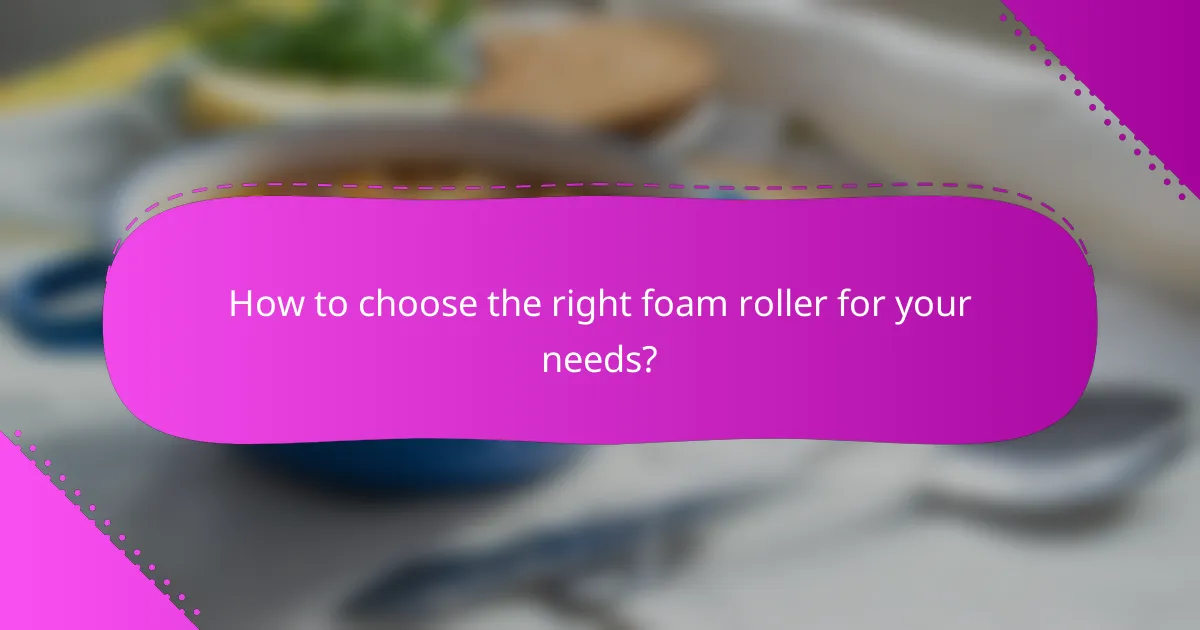
How to choose the right foam roller for your needs?
Choosing the right foam roller involves considering your fitness level, the materials used, and how frequently you plan to use it. A good foam roller should provide adequate support and durability while targeting specific muscle groups effectively.
Consider your fitness level
Your fitness level plays a crucial role in selecting a foam roller. Beginners may benefit from softer rollers that provide gentle pressure, while advanced users might prefer firmer options for deeper tissue massage. It’s essential to match the roller’s density with your experience to avoid discomfort or injury.
If you’re just starting, look for rollers in the low to mid-range price category, typically between $20 and $50. As you progress, investing in higher-quality, firmer rollers priced around $50 to $100 can enhance your recovery and performance.
Evaluate specific muscle groups targeted
Different foam rollers are designed to target various muscle groups effectively. For example, a standard cylindrical roller is versatile for overall muscle relief, while a grid or textured roller can provide deeper pressure for specific areas like the back or thighs.
Consider the muscle groups you want to focus on when selecting a roller. If you often experience tightness in your legs, a roller with a larger diameter may be beneficial. Conversely, for targeted areas like the shoulders or feet, a smaller, more compact roller can provide the precision needed for effective relief.
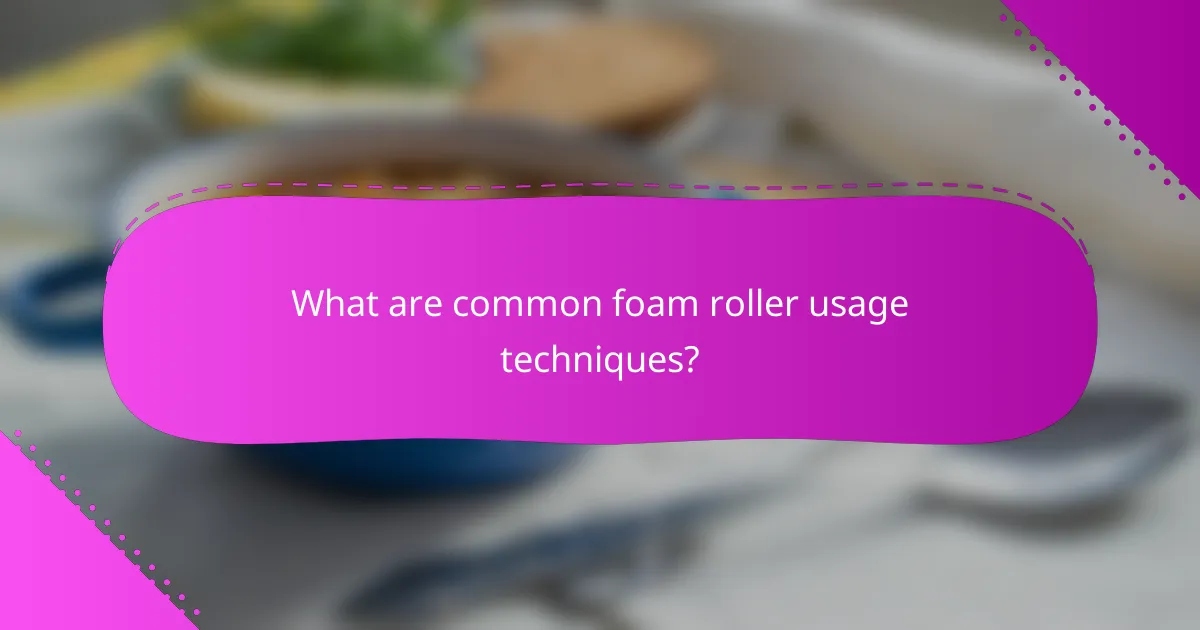
What are common foam roller usage techniques?
Common foam roller usage techniques include self-myofascial release, warm-up routines, and post-workout recovery. These techniques help alleviate muscle tightness, improve flexibility, and enhance overall performance.
Price range
The price of foam rollers typically ranges from around $10 to $100, depending on the brand, material, and features. Basic models are often more affordable, while specialized rollers with advanced textures or vibrating functions can be on the higher end.
Material quality
Foam rollers are made from various materials, including EVA foam, polyethylene, and high-density foam. Higher quality materials usually offer better durability and support, making them suitable for frequent use without losing shape.
Durability
Durability varies significantly among foam rollers, with high-density options lasting longer than softer models. A well-constructed foam roller can endure regular use for several months to years, while lower-quality versions may break down quickly.
Usage frequency
For optimal benefits, foam rollers can be used several times a week, especially after workouts or during recovery days. Regular use helps maintain muscle elasticity and prevent soreness, making it a valuable addition to any fitness routine.
